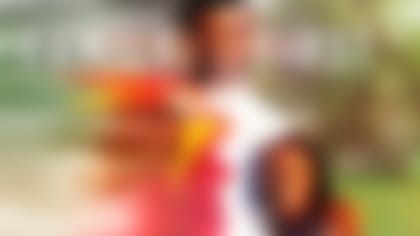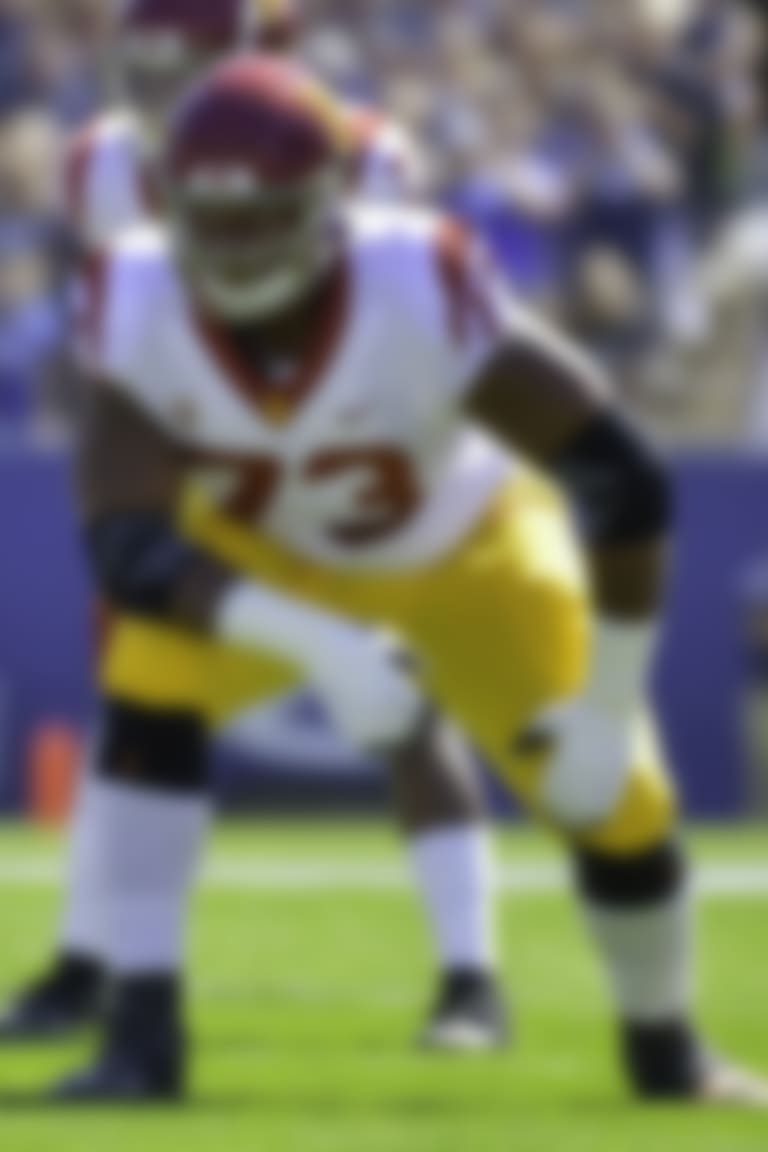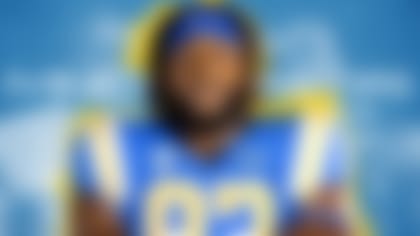When a rare blood disorder sacked his little sister, Austin Jackson selflessly put his football career at USC on hold to tackle the situation and fight for her life
By Chase Goodbread | Published Feb. 5, 2020
PHOENIX -- When the walk signal changed, Autumn Jackson trusted that 67th Avenue -- a busy, five-lane thoroughfare in Phoenix -- was safe to cross.
Austin Jackson didn't.
The siblings' daily routine in the spring of 2010 was to walk to a McDonald's on 67th after school had let out -- Austin was in sixth grade, his sister in fourth -- and wait to be picked up when their mother got off work. Halfway through the crossing, a utility truck made a speedy, illegal turn directly into the youngsters' path, when Autumn felt an abrupt jerk of her arm. Austin had grabbed his sister as he tried to jump back from danger. The driver slammed on the brakes and screeched to a halt, stopping just short of the pair, then apologized as he released the brake to move on.
A seething Austin wasn't accepting it -- he hit the back of the truck with his fist as it passed.
Autumn was her older brother's quarterback years ahead of his establishment as Southern Cal's standout left tackle and top draft prospect. Keeping himself between her and harm in any way possible was Jackson's instinct long before he realized his subsequent protection of USC quarterbacks Sam Darnold, JT Daniels and Kedon Slovis was a golden ticket. But until last summer, he had to watch from the sideline as a vicious and exceptionally rare genetic disorder known as Diamond Blackfan Anemia sacked his sister every three weeks for five years. That's how often a blood transfusion was necessary to keep Autumn alive as she navigated an assortment of health problems associated with both DBA and the transfusions themselves.
On July 9, Austin got in the game.
Doctors at Phoenix Children's Hospital performed a bone marrow transplant in which Austin's marrow was aspirated from his hip bones and, a day later, introduced into Autumn's bloodstream, with fingers crossed for her ailing body's acceptance. Jackson recovered from the procedure just in time to begin the season, but his Game 1 return to the Trojans' starting lineup belied a weeks-long struggle to perform his best. A variety of factors related to the transplant -- from the leave of absence he had to take from the team, to necessary training precautions, to soreness that lingered well into the season -- conspired to give NFL scouts an even murkier picture of his full potential for the 2020 NFL Draft.
He wouldn't have it any other way.
Austin weighed 20 pounds at 10 weeks old. Autumn, thanks to Diamond Blackfan Anemia, didn't weigh 20 pounds until she was 4 years old.
Austin was so big as a baby, his mother, Lavonna Buckhanan, struggled to carry him in one hand while still needing the other to support his bobbling head. His percentile for height and weight at his age was annually off his pediatrician's chart. In stark contrast, Autumn's was nearly off the other side of the chart, in the 6th-percentile range.
Between their vast difference in size and a natural older-brotherly instinct, it's little wonder Austin developed a watchful protectiveness of her. The two were largely inseparable growing up, fighting less frequently than typical siblings; when they did fight, it was often in a playful nature.
A close friend of the family, Sedalia Evans, recalls a 15-year-old gathering of her annual Christmas party, at which she overheard Austin, just 5 at the time, tell Autumn he would one day buy a house for the two of them to share. It would have stairs in it, he told her, just like the two-story home where the party was being hosted.
"That just showed at a young age how much he wanted to do for her," Evans said. "I never forgot it."
Their parents began to notice a bond between the two that was uniquely strong. Steven, their stepfather, saw what he called a sixth sense in Austin that was attuned to how Autumn felt, both physically and emotionally. They grew to learn more about one another than their own mother knew, Lavonna said.
Austin didn't like Autumn walking anywhere outside the home if he wasn't around to walk with her. She liked to buy candy at a nearby convenience store, and Austin would escort her there; when he was hanging around his friends, he never excluded her as typical older brothers normally would. He learned to cook and would make Autumn something every time he turned on the stove. She took her eggs scrambled, he over-easy, and without fail, he'd make them two ways to satisfy her preference.
At a younger age, he had a sense that his sister was fragile in some way, but he lacked a real understanding of what Diamond Blackfan Anemia meant. As he got older and came to learn the seriousness of the affliction, his protective nature found a fifth gear. A classmate of Autumn's at Desert Oasis Elementary once made the mistake of teasing her about her tiny size. Austin, then in fourth grade but easily the biggest kid in his class, overheard and shoved the boy, challenging him to a fight. It would be the last time Autumn had to deal with teasing from that classmate or any other.
Austin once playfully dumped his sister's boyfriend in a trash can.
"He was a good kid; I was happy for her, but the big brother in me didn't really like seeing them hold hands, flirting around or whatever," Austin said. "So, me and a friend walked past him and gave him a hard time and put him in the trash. I was always watching out for the boys she was talking to, and I always made sure they saw me."
During Lavonna's years as a single mom, having moved away from a large extended family in Sacramento, California, to live in Phoenix, Austin instinctively knew there was something more dangerous about the three of them living on their own in a new city. At night, he would check that their apartment doors and windows were locked before they went to bed. Lavonna resisted her son's fatherly tendencies at times, wanting him to enjoy his childhood more, but she took advantage of it in some ways, as well. Living at one point in a bad neighborhood she wanted out of, she would often place an older, out-of-use pair of Austin's size-14 sneakers outside their front door as a way of fooling strangers into assuming that a man -- and a large one, at that -- was home. Austin didn't mind the message those old shoes sent.
"Take a chance if you want to," Lavonna said.
The alarm bells began ringing even before Autumn's birth. Doctors had told Lavonna there were signs of anemia in her unborn daughter toward the end of her pregnancy, and on May 18, 2001, Autumn was born two weeks early by Cesarean section, because she wasn't healthy enough to endure a normal labor.
Her first transfusion came that very night.
Eight weeks later, Lavonna was sitting in the doctor's office when the results of a bone marrow biopsy came back, and the phrase Diamond Blackfan Anemia pierced her ears for the first time. She sat in silence while some horrifying truths were explained about the monster her family would be battling.
DBA prevents bone marrow from creating enough red blood cells to supply proper levels of oxygen to the body. It comes with a frightening array of abnormalities that include a vastly increased risk of cancer, birth defects and arrested physical developments. Autumn's complications included tachycardia (accelerated heart rate), vision problems, a fontanel (the soft spot on a newborn's skull) that would not close, stunted growth and a withering appetite. Until she reached 8, doctors occasionally gave her the "failure to thrive" designation, because she could barely eat for days at a time. The growth of her white blood cells was stunted, as well, which caused immunity concerns. A 100-degree fever that would barely merit a Tylenol for most would put her in the hospital.
In a global population approaching 8 billion, there are only a few thousand known cases of DBA. According to rarediseases.org, it affects only 25 to 35 of the 4 million live births in the United States each year. As such, neither doctors nor family could truly identify with Autumn's struggles.
Sympathy was possible; empathy wasn't.
Lavonna tried to turn the extreme rarity into a positive.
"The prognosis was very grim," she said. "But in my mind, I thought, 'If it's this rare, these doctors can't have any real idea how this will turn out. I don't have to go off their numbers, because they don't have enough cases to predict anything. She can have her own story.' "
For most of her life, Autumn's story was remarkable, even among DBA sufferers. Although her complications were ongoing throughout childhood, her survival only required a daily dose of Prednisone until she was 13. The steroid spurred just enough red blood cell generation in her marrow to make blood transfusions unnecessary, a blessing beyond measure for anyone afflicted with DBA. But the good fortune of one-pill maintenance didn't last.
About five years ago, Autumn's Prednisone dose began to fail, and her red cell counts dipped far too low. Blood transfusions were the only answer, even though they increased her cancer risk. They also dangerously spiked iron levels in her liver, which had to be countered with chelation therapy. Doctors first hoped one blood transfusion every six weeks would be enough, but that proved to be far too optimistic. Every six weeks became every five, then four, and finally, a brutal regimen of one transfusion every three weeks was deemed necessary to keep her alive.
As Diamond Blackfan Anemia began wreaking greater havoc on Autumn's body, it also tried to drive a wedge in her relationship with Austin.
The frequent transfusions brought about a crankiness that could make her hard to live with. Fresh off a transfusion, her attitude would always be at its best. By Day 21, right before the next treatment, she could be downright insufferable. Somewhere in the middle, it was hard to tell whether her irritability was typical teenager rancor or due to the ever-increasing need for the next transfusion. But for a while, nobody recognized the cycle.
"I thought she was just growing up not to like me," Austin said.
Autumn began slacking off on her chores, and Austin picked them up without fully realizing the reason she was becoming lethargic. Between that and her moodiness, Austin reached a breaking point of his own. He wrote each of his parents a letter -- the pen-to-paper expression designed to command more serious attention than a simple conversation -- to vent his frustration and declare that he was finished doing her work.
Underneath the tension, DBA was assaulting Autumn's body like it never had before.
Her fine motor skills frayed, and the tremor in her hands made pouring a drink steadily or tying her shoes a challenge. She had bouts of extreme fatigue and once nearly passed out just from her walk home from school. She struggled climbing stairs and had a pass at school to access an elevator. Battling her affliction began to take all the energy she had, and more.
"Especially being so close as kids, that was tough. I had to learn to be more aware of how being low on blood affected her," Austin said.
Her participation in athletics came to a permanent halt; she'd competed in track despite her tachycardia, which could take her heart rate into the 200s, and in volleyball despite her poor vision and hand tremors. Austin was a track athlete, as well, and when regular transfusions forced Autumn to quit, it was one less thing she shared with her brother.
"When she started running track, we had something else to relate to with each other," Austin said. "That all kind of went away. And all the sudden it wasn't an option. It was tough."
Nearly three years ago, doctors began discovering lesions on Autumn's liver.
The incessant blood transfusions were overloading her liver with iron -- at one point, it was measured at four times the normal level -- and a bone marrow transplant was recommended. Marrow donors must qualify with a blood test that includes 12 markers, most of which must match the recipient to have a chance at a successful transplant. Full-blood siblings are considered the most likely matches, but in the context of bone marrow transplants, most likely still means unlikely. The probability that Austin would qualify as a donor -- as Autumn's only full-blood sibling, he was by far her best chance for a match -- was less than 25 percent. His blood test proved to be a perfect 12-for-12 match.
Austin didn't hesitate. He immediately agreed to donate his marrow. His football career, doctors told him, would be unaffected, so the decision was easy.
In December, he sat in a room full of stored football records at USC's John McKay Center and reflected on the news that he could help his sister in a way nobody else could. He grinned thinking about it, shaking his head as if still in disbelief that he could have a hand in ending Autumn's ongoing nightmare.
"I was just glad I could do something," he said.
But the necessary preparation for the transplant, as well as his recovery afterward, proved to be more of an ordeal than he expected.
With the blessing of USC coach Clay Helton, Austin reported to Phoenix Children's Hospital last July to have 1.4 liters of marrow taken from the back of his hip bones. The extraction was done using a large needle with a handle at the top that doctors use to twist the needle into the bone -- Lavonna likened it to opening a wine bottle with a corkscrew -- until the marrow can be aspirated. It took more than three hours, longer than most such procedures, in part because Austin's muscularity was tough to penetrate. In fact, he ended up with two entry points in his left hip and just one in his right; his understanding is that the first attempt on his left side was unsuccessful.
Three full bags of thick, reddish-yellow liquid that he could do without were, just hours later, pumped into Autumn, who at this point had gone completely bald from a series of chemotherapy treatments to eliminate her own marrow in the week leading up to the transplant. Austin's marrow was introduced into her bloodstream through an IV at about 1 a.m. as he slept in a chair at his girlfriend's house, in too much pain to sleep on a bed. For another week, he could only sleep on his right side. He couldn't bend at the knees without pain and pondered whether his starting role on the Trojans' offensive line -- with the season set to start in less than two months -- would be jeopardized.
Meanwhile, Lavonna's hands wrung. Autumn's quality of life was at stake, and so, too, was Austin's readiness for the most important season of his promising football career. How would Autumn respond if the procedure failed, and would that failure plant an irrevocable guilt in Austin? As a child, Lavonna had watched her father undergo a bone marrow transplant that came with just a 30 percent success rate. She watched him shrivel from a 6-foot-6, 300-pound man to just 160. It was an autologous transplant -- different from Autumn's in that he was his own donor -- but the experience was haunting.
"I had two kids (Austin and Autumn) under anesthesia at the same time. It's nerve-racking," Lavonna said. "I'm a risk manager -- I worked in insurance for 15 years, so 'but what if' lives in my brain at all times. They can tell you it's low-risk, but it's my risk. My babies."













